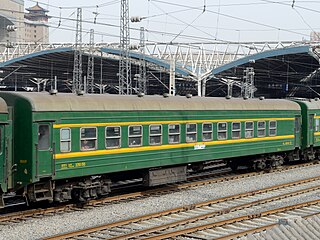
A railroad car, railcar, railway wagon, railway carriage, railway truck, railwagon, railcarriage or railtruck, also called a train car, train wagon, train carriage or train truck, is a vehicle used for the carrying of cargo or passengers on a rail transport network. Such cars, when coupled together and hauled by one or more locomotives, form a train. Alternatively, some passenger cars are self-propelled in which case they may be either single railcars or make up multiple units.
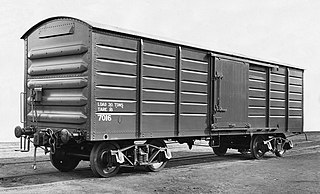
A boxcar is the North American (AAR) term for a railroad car that is enclosed and generally used to carry freight. The boxcar, while not the simplest freight car design, is considered one of the most versatile since it can carry most loads. Boxcars have side sliding doors of varying size and operation, and some include end doors and adjustable bulkheads to load very large items. Some boxcars are refrigerated too.

A loading gauge is a diagram or physical structure that defines the maximum height and width dimensions in railway vehicles and their loads. Their purpose is to ensure that rail vehicles can pass safely through tunnels and under bridges, and keep clear of platforms, trackside buildings and structures. Classification systems vary between different countries, and gauges may vary across a network, even if the track gauge is uniform.
The UIC classification of locomotive axle arrangements, sometimes known as the German classification or German system, describes the wheel arrangement of locomotives, multiple units and trams. It is used in much of the world, notable exceptions being the United Kingdom, which uses a slightly simplified form of UIC, and in North America, where the AAR wheel arrangement system is used to describe diesel and electric locomotives. In North America, the Whyte notation is only used for steam locomotives.

The International Union of Railways is an international rail transport industry body.
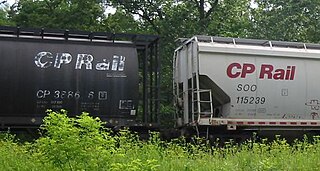
A reporting mark is a code used to identify owners or lessees of rolling stock and other equipment used on certain rail transport networks. The code typically reflects the name or identifying number of the owner, lessee, or operator of the equipment.

A buffer is a part of the buffers-and-chain coupling system used on the railway systems of many countries, among them most of those in Europe, for attaching railway vehicles to one another.
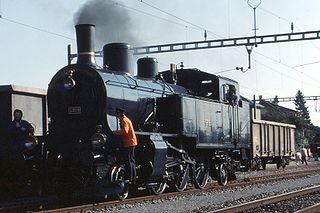
For more than a century, the Swiss locomotive, multiple unit, motor coach and railcar classification system, in either its original or updated forms, has been used to name and classify the rolling stock operated on the railways of Switzerland. It started out as a uniform system for the classification and naming of all rolling stock, powered and unpowered, but had been replaced and amended by the UIC classification of goods wagons.

Goods wagons or freight wagons, also known as goods carriages, goods trucks, freight carriages or freight trucks, are unpowered railway vehicles that are used for the transportation of cargo. A variety of wagon types are in use to handle different types of goods, but all goods wagons in a regional network typically have standardized couplers and other fittings, such as hoses for air brakes, allowing different wagon types to be assembled into trains. For tracking and identification purposes, goods wagons are generally assigned a unique identifier, typically a UIC wagon number, or in North America, a company reporting mark plus a company specific serial number.
Railway coaches are classified under an international system developed by the UIC. This UIC classification of railway coaches replaced earlier national classification schemes in many countries, such as Germany. The coach class is expressed as a combination of letters. It is sometimes followed, for example in the Deutsche Bahn AG, by a three-figure class number. In a broader sense the vehicle number displayed on the coach is also part of its classification, because it encodes other technical details such as the top speed or the type of heating system used.

Flat wagons, as classified by the International Union of Railways (UIC), are railway goods wagons that have a flat, usually full-length, deck and little or no superstructure. By contrast, open wagons have high side and end walls and covered goods wagons have a fixed roof and sides. Flat wagons are often designed for the transportation of goods that are not weather-sensitive. Some flat wagons are able to be covered completely by tarpaulins or hoods and are therefore suitable for the transport of weather-sensitive goods. Unlike a "goods wagon with opening roof", the loading area of a flat is entirely open and accessible once the cover is removed.

This list contains the UIC classification of goods wagons and their meanings. The description is made up of a category letter and usually several index letters.
The UIC identification marking for tractive stock is a standard for identifying train stock like locomotives that supply tractive force primarily in Europe. Since the beginning of 2007 locomotives or other traction units in Europe have been given a 12-digit number. Vehicle numbering is now governed by the Intergovernmental Organisation for International Carriage by Rail and in Technical Specifications for Interoperability (TSI) of the European Union, specifically the European Railway Agency's CR OPE TSI. This makes the locomotive clearly identifiable within Europe and parts of Asia and northern Africa.

Wagon numbers are key data for railway operations. They enable a railway wagon or coach to be positively identified and form a common language between railway operators, infrastructure companies and the state authorities. The system of wagon numbering has been laid down by the International Union of Railways and is similar to that used for the locomotives and multiple units. Vehicle numbering is now governed by the Intergovernmental Organisation for International Carriage by Rail and in Technical Specifications for Interoperability (TSI) of the European Union.
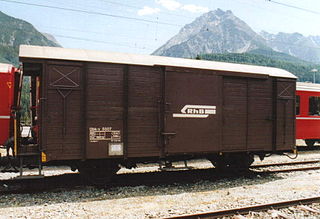
A covered goods wagon or van is a railway goods wagon which is designed for the transportation of moisture-susceptible goods and therefore fully enclosed by sides and a fixed roof. They are often referred to simply as covered wagons, and this is the term used by the International Union of Railways (UIC). Since the introduction of the international classification for goods wagons by the UIC in the 1960s a distinction has been drawn between ordinary and special covered wagons. Other types of wagon, such as refrigerated vans and goods wagons with opening roofs, are closely related to covered wagons from a design point of view. Similar freight cars in North America are called boxcars.

The International Coach Regulations or RIC were first agreed in 1922 and covered the international use of railway passenger coaches between European railways. Until 1982 the RIC was looked after by the Swiss Federal Railways, but since then the International Union of Railways (UIC) has taken responsibility for them. Today 27 railway companies from all the European countries apart from the United Kingdom, Ireland and Finland are party to the RIC agreement.
The wagon with opening roof is a type of railway goods wagon that is, nowadays, defined and standardised by the International Union of Railways (UIC) as Class "T". They are a large category of rail vehicle, predominantly used for the transport of hygroscopic bulk commodities such as cement, plaster, lime, potash and grain.
A pocket wagon is a freight wagon that has been specially designed for the transport of truck semi-trailers. This wagon belongs to the group of flat wagons in special design with bogies and is used in combined transport (CT). The name of these freight wagons comes from the fact that between the narrow longitudinal girders on the outside and also lengthways between the bogies, the so-called pockets are located, in which the wheels of the semi-trailers are particularly low. For flexible use in CT, pocket wagons have hinged latches with ISO spigots on the solebar, so that containers and swap bodies up to 45 ft can be accommodated. As a flat wagon, it bears the UIC generic letter S and, since it is intended for the transport of road vehicles on one level, the code letter d. Since it is also possible to transport containers in a pocket wagon, it bears the UIC generic mark Sdgs. In this context, the code letter g stands for "containers up to 60 feet" and the lower case s for the permitted speed of up to 100 km/h (62 mph). The wagons have a yellow triangle with a black P on the long side. The first pocket wagons were built in Germany as early as 1972 and further developed according to requirements.












